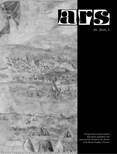
Journal ARS 49 (2016) 1
Giorgio CASELLI
La veduta di Bratislava nel Cortile di Michelozzo in Palazzo Vecchio
(Summary)
The current appearance of a main courtyard of the Palazzo Vecchio is a work of Giorgio Vasari of Arezzo. It was completed in 1565 on the occasion of the weeding between Francesca, son of Cosimo I de’ Medici and Eleonora di Toledo, and Giovanna d’Austria, sister of the Habsburg emperor, Maximilian II. Vasari´s decoration is interwoven with that of Michelozzo Michelozzi, completed in 1453. He was commissioned to reinforce the columns of Arnolfo´s portal, however, during the works the medieval Arnolfo´s courtyard was transformed into a Renaissance one. The arches of inner portal faced, supported by columns decorated with stucco reliefs, show the views of 14 cities of Habsburg empire, framed with stucco profiles and strips with grottesche. Refined grottesche on the vaults are framed with painted medallions. Up to the 1930s, the restoration interventions to the decoration of Michelozzo´s courtyard were very poorly documented. In 1812, based on the project of Giuseppe del Rosso, a very significant intervention was made. It was carried out within a wide range of construction works focused on the preservation of degraded originals and adjustment of the Palazzo Vecchio to its new functions. The decoration of the courtyard was restored in compliance with current methods and taste, which was also reflected in the interventions to original frescos. Other restoration works, the documentation of which can be found in the Historical Archives of Florence (Archivio Storico del Comune di Firenze), were carried out in the 20th century as follows: 1935 – 1942; removal of war damages in 1944; 1950s – 1960s; restoration of the views of Hall, Constance and Wiener Neustadt as well as of the vault of a southern portal and part of the western portal in 1989; restoration of the views of Vienna, Innsbruck and Ebersdorf on the same portal and of the part of eastern portal in 1993. In 2005, the local government continued in carrying out the restoration works, which had been suspended in 1999. In 2007, the first phase was completed, which included the restoration of the frieze with Salviati´s frescos on the first register of inner facades and columns with stucco reliefs. The second phase, i.e. the restoration of western and northern portals in sections comprising the views of Passau, Klosterneuburg, Graz, and Freiburg, was completed in 2012. In the period of 2013 – 2015, the third phase of restoration works was completed, funded by Kuipo LTD and Co-Genten, which focused on the restoration of the eastern portal including the veduta of Bratislava. Veduta of Bratislava – Possonia The view of Bratislava, identified by the inscription Possonia in the upper part and Posonium Hungariae civita (in qua Maximilianus coronatus fuit) in the lower part, was, like all the other vedute, overlaid with an oval decorative element placed in the centre of the lunette, which depicted the examples of good rule of Cosimo I. During the 1812 intervention designed by an architect Giuseppe del Rosso, the entire Vasari´s decoration including the view of Bratislava was changed considerably. The imitative over-painting that applied 19th century techniques using empirical methods, which were ineffective in terms of conservation and aesthetics, was removed in the 20th century. However, the overall cleaning of fresco surfaces, removal of dust using soft part of the bread, and cleaning of surface deposits led to the removal of particles of paint layer, which separated or showed the signs of sulphating as well as other forms of degradation. In cases like this, in order to return murals their readability that have been lost as a result of abrasion and missing fragments, the restorers approached the reinterpretation of what remained visible in the original painting and was considered to be strongly damaged based on tempera retouching. The view of Bratislava was among the few vedute that were not transferred on fibreboard base during the intervention in the 20th century. The method of transfer was applied with most vedute due to the presence of soluble salts on the painting surface, which crystallised in the plaster, causing crumbling of paint layer. The view of Bratislava too was affected by sulphating processes. There was a layer of degrading substances intended for fixation and refreshment of colours on the painting surface, which came from previous interventions and which had organic and chemical nature. The strong deposits of dirty particles of air firmly adhered to the substances. The continuing high degradation of the entire painting surface required the use of complex conservation methods. After evaluating results of scientific analyses, made before the intervention, the veduta was restored using the methods applied in case of other views preserved in-situ. With respect to a serious aesthetic threat and urgent need to preserve the entire composition, the frescoes were restored with the maximum possible care. The restorers applied sensitive tinting of colours to reduce their richness in the spots affected by abrasion with the aim to reintegrate pigments and plaster in the spots with missing painting, using mineral pigments softened in casein solution. The aim of the restoration uniting individual parts of the composition was to revitalise the view of Bratislava so that the original, considerably damaged parts could coexist with historically accepted reconstructions in a harmonious whole.